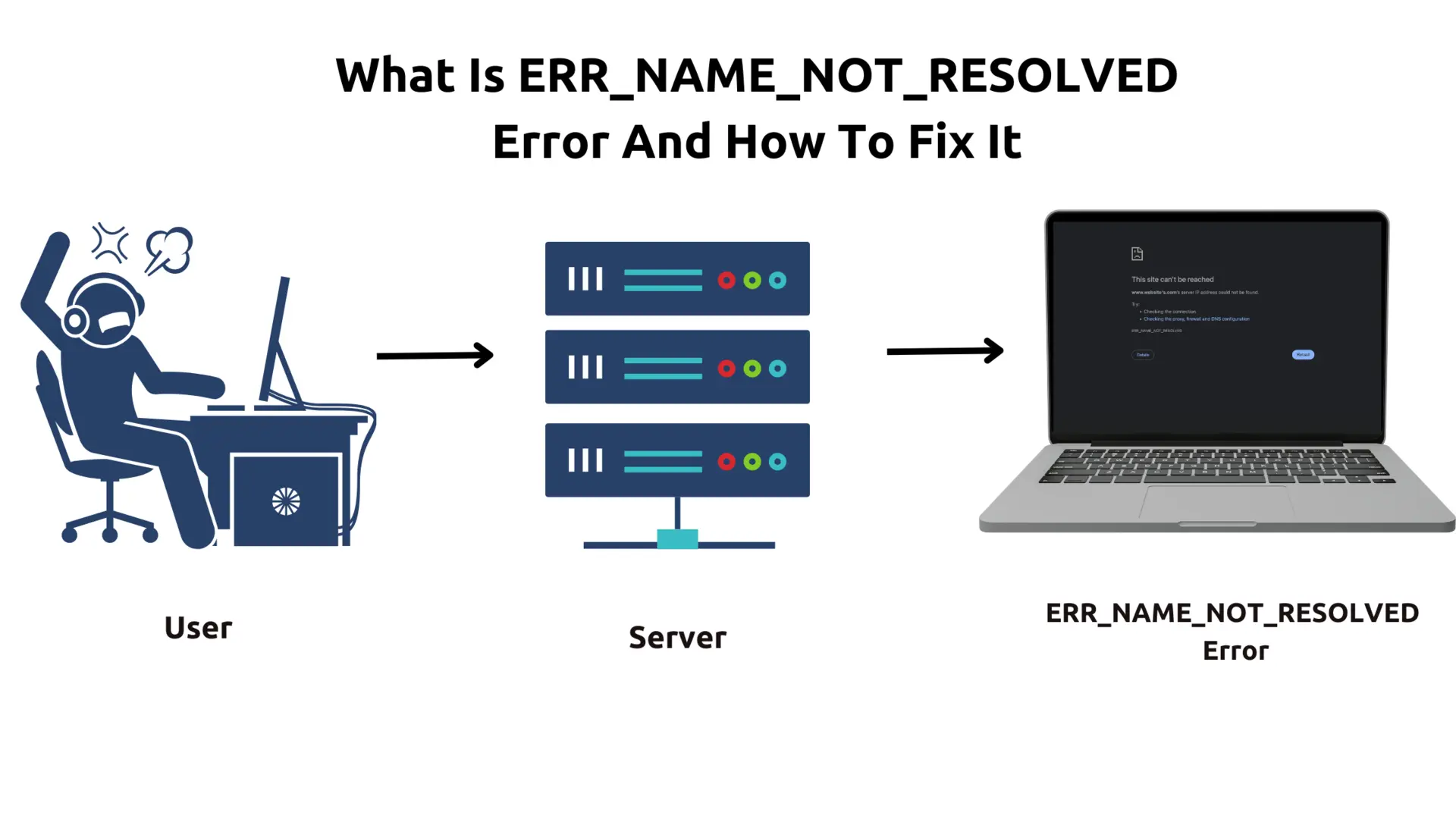
The ERR_NAME_NOT_RESOLVED error is one of those frustrating roadblocks that can stop your development workflow dead in its tracks. Whether you’re testing a local application, debugging API endpoints, or simply browsing the web, this DNS resolution failure can appear in
Chrome,
Firefox, and
Edge when your browser can’t translate a domain name into its corresponding IP address.
As developers, we know that DNS (Domain Name System) acts as the internet’s phonebook, converting human-readable domain names into machine-readable IP addresses. When this translation process fails, your browser throws the ERR_NAME_NOT_RESOLVED error, leaving you unable to reach your destination.
Summary
- Double Check the URL
- Make sure there are no typos, spaces, or extra characters in the website address.
- Verify DNS Resolution via Command Line
- Clear DNS Cache
- Flush your DNS cache to remove outdated data.
- Windows:
ipconfig /flushdns - macOS:
sudo dscacheutil -flushcache
- Change DNS Servers
- Switch to Google DNS or Cloudflare DNS for faster and more reliable resolution.
- Google DNS:
8.8.8.8 and 8.8.4.4
- Clear Browser Cache and Cookies
- Clear your browser’s cache and cookies to fix DNS issues caused by stored data.
- Disable Browser Prediction Services
- Disable Chrome’s “Preload pages” setting to prevent interference with DNS.
- Check Your Firewall and Antivirus Settings
- Temporarily disable firewall/antivirus to check if they’re blocking DNS queries.
- Verify Your Hosts File
- Ensure there are no incorrect entries in your system’s hosts file.
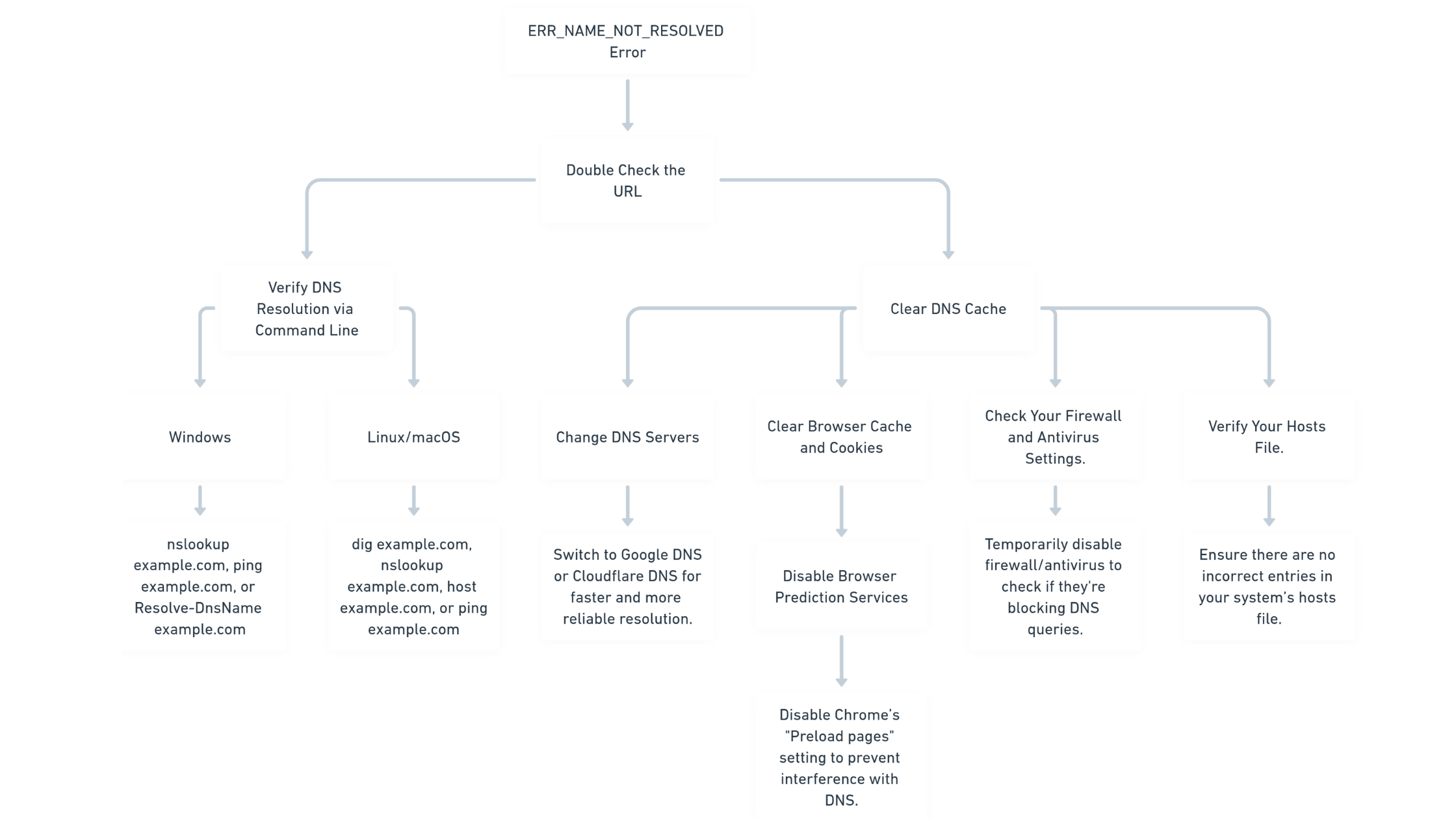
What Causes ERR_NAME_NOT_RESOLVED?
Understanding the root causes helps you troubleshoot more effectively. Here are the most common culprits behind this DNS resolution error:
Incorrect URL or Domain Name - Simple typos, extra spaces, or wrong TLD extensions (.com vs .co) are surprisingly common. Even developers can miss these when quickly typing URLs during testing.
DNS Server Problems - Your configured DNS server might be experiencing downtime, high latency, or configuration issues. ISP-provided DNS servers are particularly prone to these problems.
Stale DNS Cache - Both your operating system and browser cache DNS lookups to improve performance. When these caches contain outdated information, they can prevent successful resolution of updated domain records.
Network Configuration Issues - Misconfigured DNS settings, incorrect network adapter configurations, or problems with your router’s DNS forwarding can all trigger this error.
Security Software Interference - Overzealous firewalls, antivirus programs, or network security tools may block legitimate DNS queries, especially when they’re configured with strict security policies.
Hosts File Conflicts - Manual entries in your system’s hosts file can override DNS resolution, potentially blocking access to specific domains if configured incorrectly.
Step-by-Step Solutions to Fix ERR_NAME_NOT_RESOLVED
1. Double Check the URL
Before diving into technical fixes, ensure the website address you’ve typed is correct. A simple typo in the domain name or an extra space can cause the browser to fail in resolving the site. Even an unnoticed mistake like .co instead of .com or a misplaced character can trigger this error.
Solution: Carefully check the URL for any errors or unnecessary spaces. If possible, try accessing the website using a different device to verify that the issue is not due to a typo.
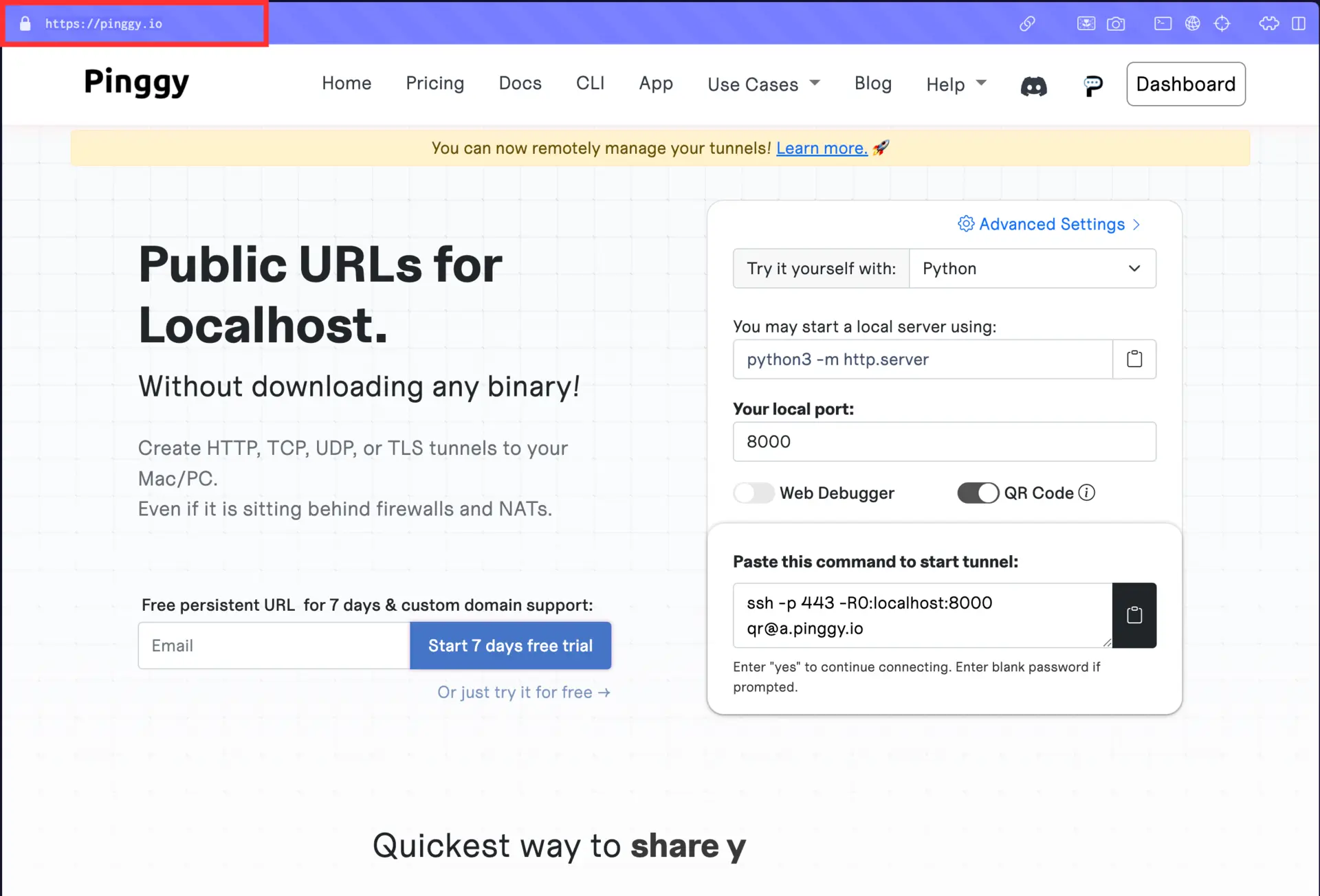
2. Verify DNS Resolution
These commands help confirm whether DNS resolution is functioning correctly and can identify if the issue lies with DNS settings or connectivity.
If DNS lookup is successful, the output will display the resolved IP address of the domain (e.g., Name: example.com Address: 93.184.216.34).
If DNS lookup fails, the output will indicate an error such as Non-existent domain, NXDOMAIN, or connection timed out; no servers could be reached.
3. Clear DNS Cache
DNS caching improves performance by storing recent lookups, but stale cache entries can cause resolution failures. When you’re developing and testing with frequently changing DNS records, clearing the cache is often necessary.
Windows:
# Open Command Prompt as Administrator and run:
ipconfig /flushdns
# Verify the cache was cleared:
ipconfig /displaydns
macOS:
# Clear DNS cache (requires admin password):
sudo dscacheutil -flushcache
# For older macOS versions, you might need:
sudo killall -HUP mDNSResponder
Linux:
# For systemd-resolved (Ubuntu 18.04+):
sudo systemd-resolve --flush-caches
# For older systems with nscd:
sudo service nscd restart

Pro tip: If you’re frequently switching between development environments, consider scripting these commands for quick cache clearing.
4. Switch to Reliable DNS Servers
Your ISP’s default DNS servers might be slow, unreliable, or experiencing outages. Switching to public DNS providers often resolves these issues and can improve overall browsing performance.
Recommended DNS Providers:
Quick DNS Change via Command Line:
Windows (PowerShell as Administrator):
# Set DNS to Cloudflare
netsh interface ip set dns "Wi-Fi" static 1.1.1.1
netsh interface ip add dns "Wi-Fi" 1.0.0.1 index=2
# Or use Google DNS
netsh interface ip set dns "Wi-Fi" static 8.8.8.8
netsh interface ip add dns "Wi-Fi" 8.8.4.4 index=2
macOS/Linux:
# Temporarily test with different DNS (doesn't persist)
dig @1.1.1.1 example.com
dig @8.8.8.8 example.com
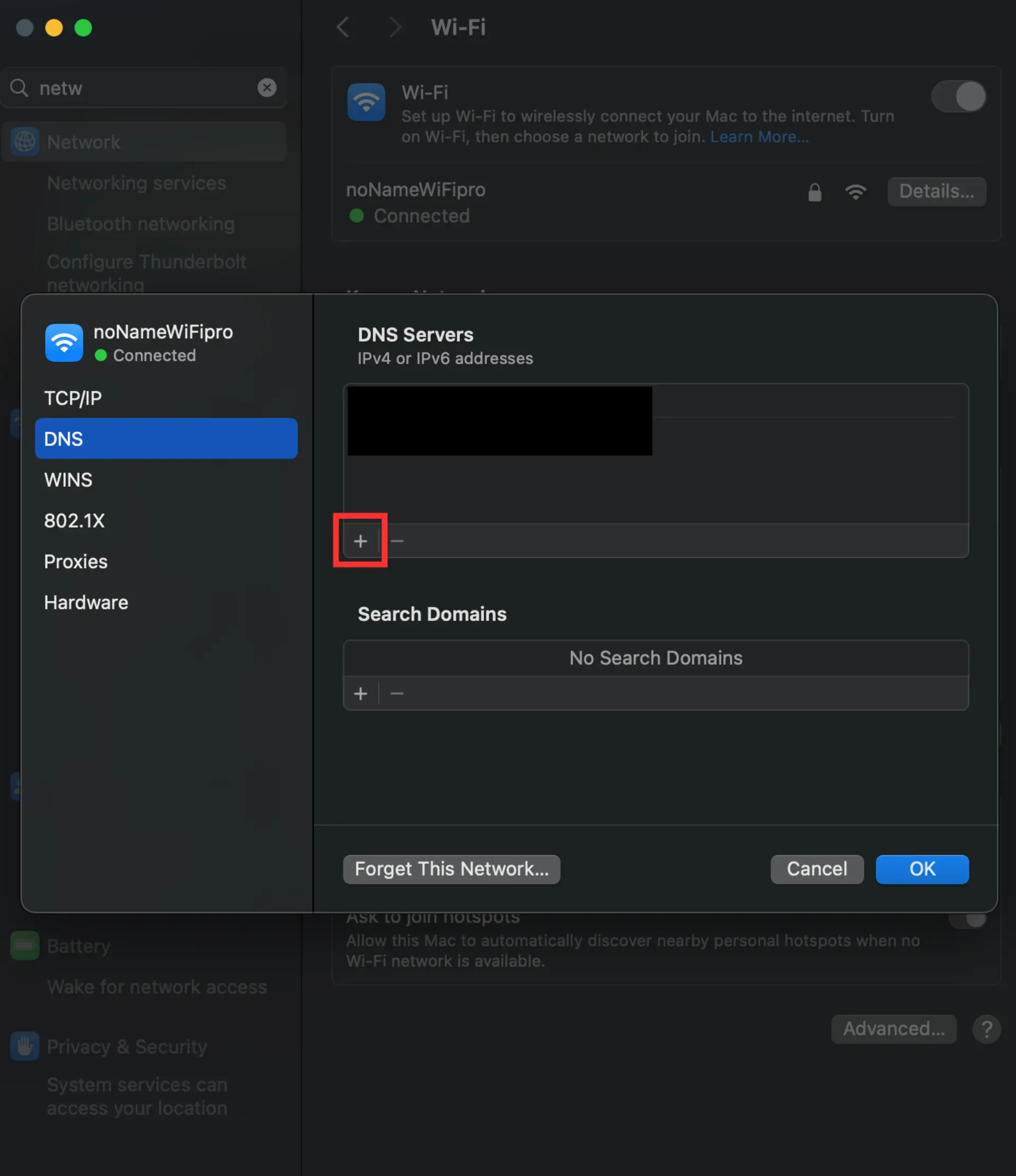
For permanent changes, use your system’s network settings GUI or modify /etc/resolv.conf on Linux systems.
5. Clear Browser Cache and Cookies
Your browser’s cache and cookies can sometimes interfere with DNS resolution. Clearing the cache can help resolve any issues caused by outdated or corrupt files.
Solution:
- Open your browser settings, go to Privacy or History settings, and clear browsing data, including cached images, cookies, and other site data.
- Restart your browser and try to visit the website again.

6. Disable Browser Prediction Services
Browsers like
Chrome use predictive algorithms to preload pages, which can sometimes interfere with DNS resolution. Disabling these services might resolve the error.
Solution:
- Open Chrome and go to Settings.
- Navigate to Privacy and Security.
- Disable the option “Preload pages for faster browsing and searching.”
Disabling this setting can stop
Chrome from attempting to pre-resolve websites that might conflict with DNS settings.
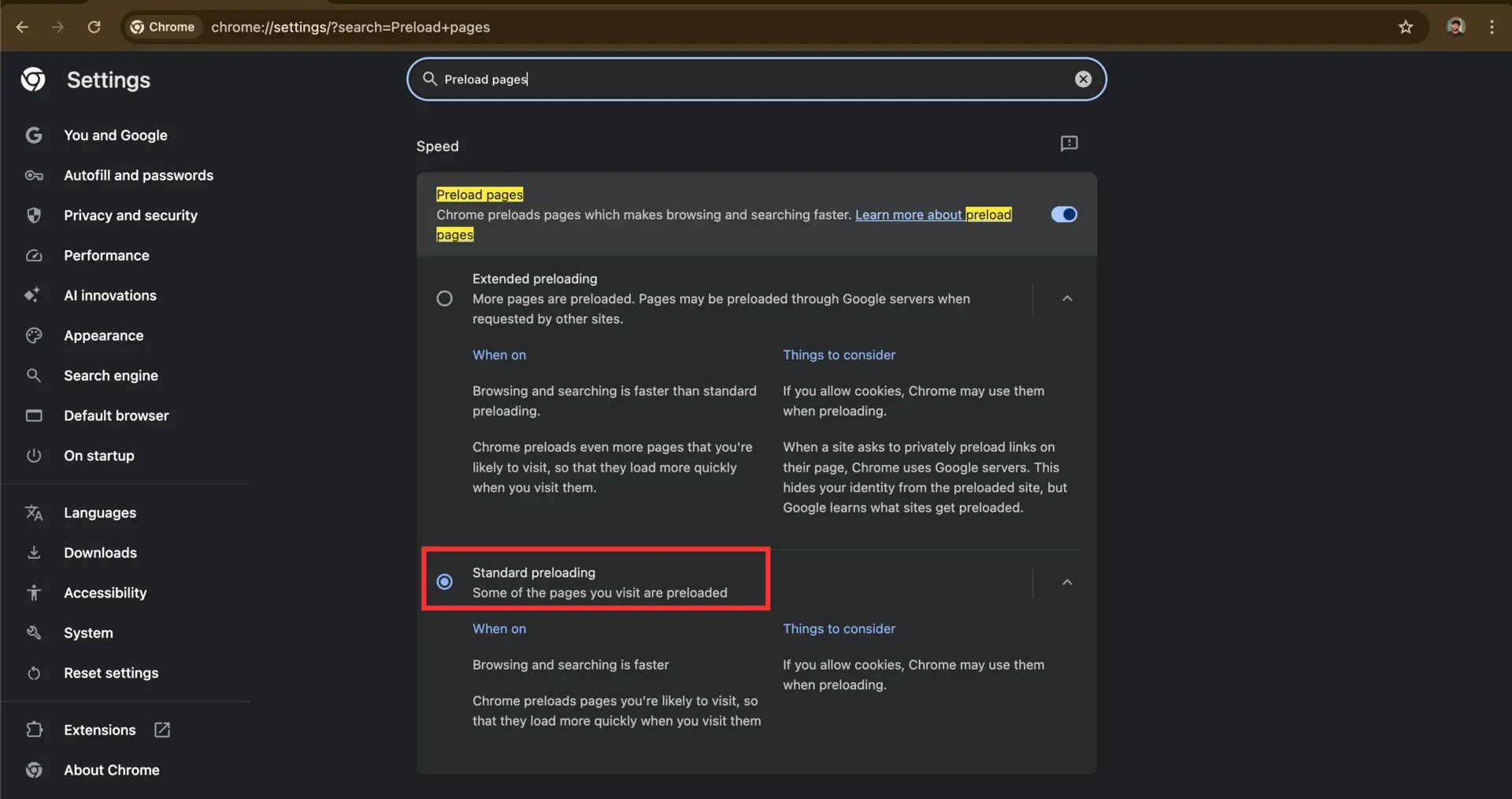
7. Check Your Firewall and Antivirus Settings
In some cases, your firewall or antivirus software might block DNS queries, causing the error. Disabling your firewall or antivirus temporarily can help determine if they are the cause.
Solution:
- Temporarily disable your firewall or antivirus software.
- If the website loads, adjust your firewall or antivirus settings to allow DNS queries, or whitelist the website you’re trying to access.
Make sure to enable your firewall or antivirus again after troubleshooting.
8. Verify Your Hosts File
The hosts file on your computer contains mappings of IP addresses to domain names. If there are incorrect entries in this file, it could block access to certain websites.
Solution:
- Windows:
- Open File Explorer and navigate to
C:\Windows\System32\drivers\etc\hosts. - Open the file in a text editor (e.g., Notepad).
- Remove or correct any incorrect entries.
- macOS:
- Open Terminal and type
sudo nano /etc/hosts. - Review the file and remove any incorrect mappings.
- Save the file and exit (press
CTRL + X, then Y to confirm, and Enter).
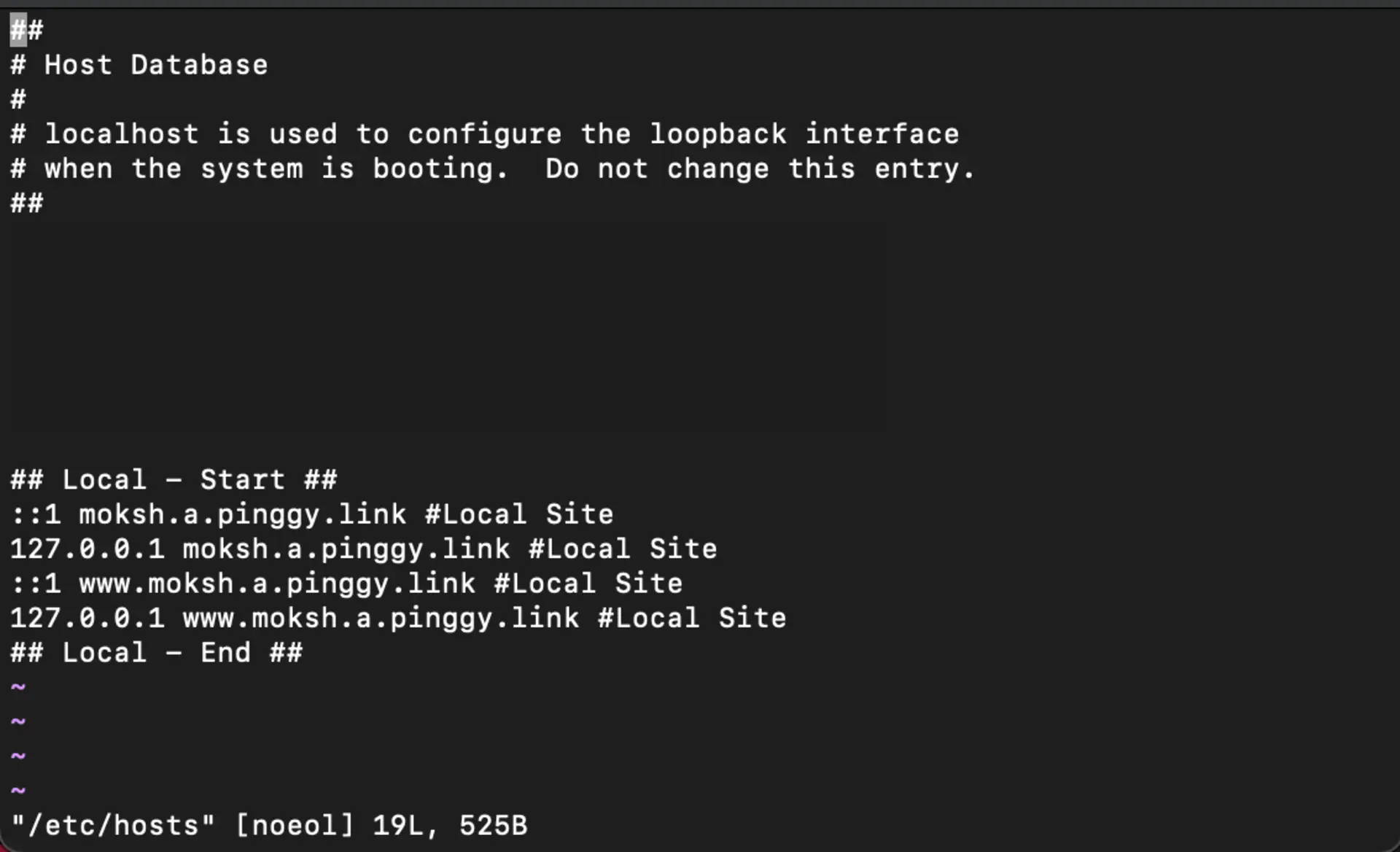
Once the hosts file is corrected, try reloading the website.
Advanced DNS Troubleshooting for Developers
Using dig for Detailed DNS Analysis
The dig command provides comprehensive DNS information that’s invaluable for debugging:
# Basic A record lookup
dig example.com
# Query specific DNS server
dig @8.8.8.8 example.com
# Get all DNS record types
dig example.com ANY
# Trace the full DNS resolution path
dig +trace example.com
# Check reverse DNS lookup
dig -x 93.184.216.34
DNS Propagation Testing
When you’ve recently changed DNS records, test propagation across different servers:
# Test multiple DNS servers
for server in 8.8.8.8 1.1.1.1 9.9.9.9; do
echo "Testing $server:"
dig @$server example.com +short
done
Browser-Specific DNS Issues
Chrome DNS Cache: Chrome maintains its own DNS cache. Clear it by visiting:
chrome://net-internals/#dns
Click “Clear host cache” to flush Chrome’s internal DNS cache.
Firefox DNS Cache: Disable DNS caching in Firefox for development:
- Go to
about:config - Set
network.dnsCacheExpiration to 0
Network-Level Debugging
Check if the issue is network-specific:
# Test from different network interfaces
ping -I eth0 example.com
ping -I wlan0 example.com
# Check routing table
route -n # Linux
netstat -rn # macOS/BSD
To begin, ensure your Foundry VTT instance is running on your local machine. By default, Foundry operates on port 30000.
Start the Foundry VTT Application
Launch the Foundry VTT application as you normally would.
Check Local Network Access
Navigate to Game > Access > Local Network within the Foundry interface. Here, you’ll see the local network address where Foundry is running, such as:
http://10.123.1.136:30000
Verify the Server is Running
Open your web browser and go to:
If everything is set up correctly, you should see the Foundry VTT login page or welcome screen.
Prevention and Best Practices for Developers
Use Reliable DNS Infrastructure
For production environments, avoid relying on ISP-provided DNS servers. Instead, configure your systems to use enterprise-grade DNS providers:
- Cloudflare DNS:
1.1.1.1 and 1.0.0.1 (fastest response times) - Google DNS:
8.8.8.8 and 8.8.4.4 (reliable and widely supported) - Quad9:
9.9.9.9 (security-focused with malware blocking)
Development Environment Tips
Local Development: When working with local services, consider using .local domains or editing your hosts file for consistent resolution:
# Add to /etc/hosts (Linux/macOS) or C:\Windows\System32\drivers\etc\hosts (Windows)
127.0.0.1 myapp.local
127.0.0.1 api.myapp.local
Docker Development: Use Docker’s internal DNS resolution for container-to-container communication instead of relying on external DNS.
Monitoring and Automation
Set up DNS monitoring for critical domains and automate cache clearing in your deployment scripts:
#!/bin/bash
# Example deployment script snippet
echo "Clearing DNS cache..."
sudo systemd-resolve --flush-caches
echo "DNS cache cleared"
- Cloudflare DNS: Fast, privacy-focused DNS with excellent uptime
- Google Public DNS: Reliable DNS service with global infrastructure
- dig/nslookup: Essential command-line tools for DNS troubleshooting
- Browser DevTools: Network tab for monitoring DNS resolution timing
Special Case: Dynamic DNS Services
When working with dynamic DNS services like
Pinggy, you might encounter ERR_NAME_NOT_RESOLVED errors due to DNS propagation delays.
Pinggy dynamically assigns
DNS records when tunnels are created, which can cause temporary resolution failures.
Solution for Dynamic DNS: Wait 10-15 seconds after tunnel creation before accessing the URL, as the TTL (Time-To-Live) for these records is typically very short.
Conclusion
The ERR_NAME_NOT_RESOLVED error can be caused by a variety of factors, from simple typing mistakes to more complex network or DNS configuration problems. By following the above step-by-step troubleshooting methods, you can resolve most issues and get back to browsing without interruptions.